Rongzhi Dong
Facet: highly efficient E(3)-equivariant networks for interatomic potentials
Sep 10, 2025Abstract:Computational materials discovery is limited by the high cost of first-principles calculations. Machine learning (ML) potentials that predict energies from crystal structures are promising, but existing methods face computational bottlenecks. Steerable graph neural networks (GNNs) encode geometry with spherical harmonics, respecting atomic symmetries -- permutation, rotation, and translation -- for physically realistic predictions. Yet maintaining equivariance is difficult: activation functions must be modified, and each layer must handle multiple data types for different harmonic orders. We present Facet, a GNN architecture for efficient ML potentials, developed through systematic analysis of steerable GNNs. Our innovations include replacing expensive multi-layer perceptrons (MLPs) for interatomic distances with splines, which match performance while cutting computational and memory demands. We also introduce a general-purpose equivariant layer that mixes node information via spherical grid projection followed by standard MLPs -- faster than tensor products and more expressive than linear or gate layers. On the MPTrj dataset, Facet matches leading models with far fewer parameters and under 10% of their training compute. On a crystal relaxation task, it runs twice as fast as MACE models. We further show SevenNet-0's parameters can be reduced by over 25% with no accuracy loss. These techniques enable more than 10x faster training of large-scale foundation models for ML potentials, potentially reshaping computational materials discovery.
AlphaCrystal-II: Distance matrix based crystal structure prediction using deep learning
Apr 07, 2024Abstract:Computational prediction of stable crystal structures has a profound impact on the large-scale discovery of novel functional materials. However, predicting the crystal structure solely from a material's composition or formula is a promising yet challenging task, as traditional ab initio crystal structure prediction (CSP) methods rely on time-consuming global searches and first-principles free energy calculations. Inspired by the recent success of deep learning approaches in protein structure prediction, which utilize pairwise amino acid interactions to describe 3D structures, we present AlphaCrystal-II, a novel knowledge-based solution that exploits the abundant inter-atomic interaction patterns found in existing known crystal structures. AlphaCrystal-II predicts the atomic distance matrix of a target crystal material and employs this matrix to reconstruct its 3D crystal structure. By leveraging the wealth of inter-atomic relationships of known crystal structures, our approach demonstrates remarkable effectiveness and reliability in structure prediction through comprehensive experiments. This work highlights the potential of data-driven methods in accelerating the discovery and design of new materials with tailored properties.
Structure-based out-of-distribution (OOD) materials property prediction: a benchmark study
Jan 16, 2024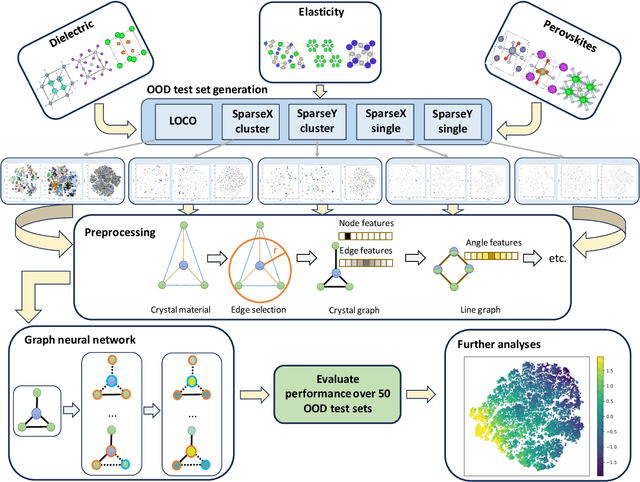
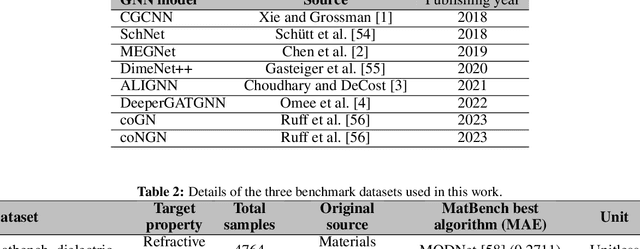

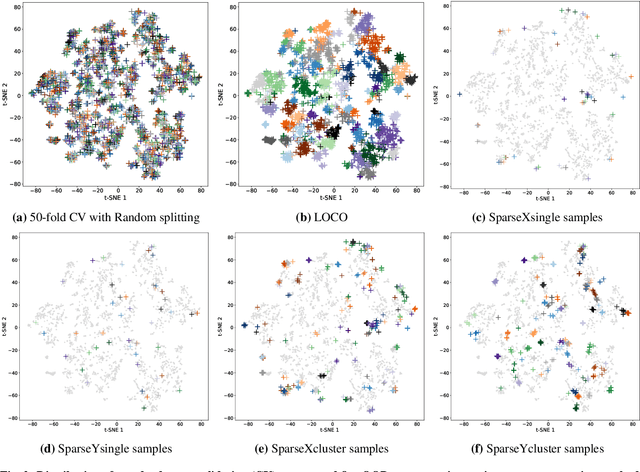
Abstract:In real-world material research, machine learning (ML) models are usually expected to predict and discover novel exceptional materials that deviate from the known materials. It is thus a pressing question to provide an objective evaluation of ML model performances in property prediction of out-of-distribution (OOD) materials that are different from the training set distribution. Traditional performance evaluation of materials property prediction models through random splitting of the dataset frequently results in artificially high performance assessments due to the inherent redundancy of typical material datasets. Here we present a comprehensive benchmark study of structure-based graph neural networks (GNNs) for extrapolative OOD materials property prediction. We formulate five different categories of OOD ML problems for three benchmark datasets from the MatBench study. Our extensive experiments show that current state-of-the-art GNN algorithms significantly underperform for the OOD property prediction tasks on average compared to their baselines in the MatBench study, demonstrating a crucial generalization gap in realistic material prediction tasks. We further examine the latent physical spaces of these GNN models and identify the sources of CGCNN, ALIGNN, and DeeperGATGNN's significantly more robust OOD performance than those of the current best models in the MatBench study (coGN and coNGN), and provide insights to improve their performance.
Generative Design of inorganic compounds using deep diffusion language models
Sep 30, 2023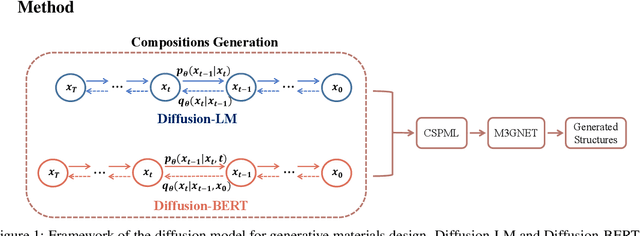

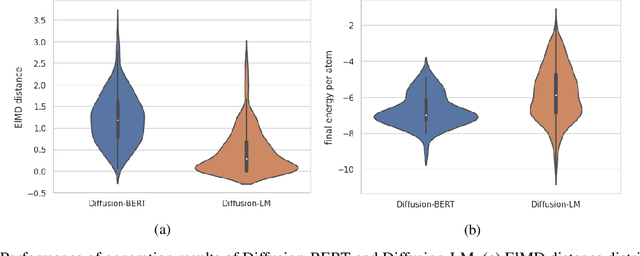
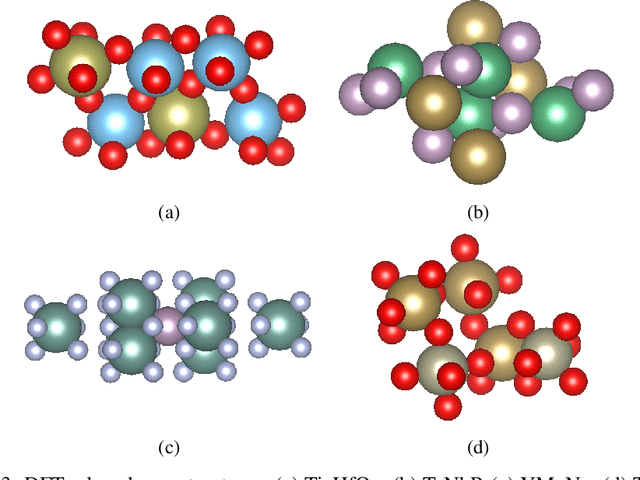
Abstract:Due to the vast chemical space, discovering materials with a specific function is challenging. Chemical formulas are obligated to conform to a set of exacting criteria such as charge neutrality, balanced electronegativity, synthesizability, and mechanical stability. In response to this formidable task, we introduce a deep learning-based generative model for material composition and structure design by learning and exploiting explicit and implicit chemical knowledge. Our pipeline first uses deep diffusion language models as the generator of compositions and then applies a template-based crystal structure prediction algorithm to predict their corresponding structures, which is then followed by structure relaxation using a universal graph neural network-based potential. The density functional theory (DFT) calculations of the formation energies and energy-above-the-hull analysis are used to validate new structures generated through our pipeline. Based on the DFT calculation results, six new materials, including Ti2HfO5, TaNbP, YMoN2, TaReO4, HfTiO2, and HfMnO2, with formation energy less than zero have been found. Remarkably, among these, four materials, namely Ti2$HfO5, TaNbP, YMoN2, and TaReO4, exhibit an e-above-hull energy of less than 0.3 eV. These findings have proved the effectiveness of our approach.
Discovery of 2D materials using Transformer Network based Generative Design
Jan 14, 2023Abstract:Two-dimensional (2D) materials have wide applications in superconductors, quantum, and topological materials. However, their rational design is not well established, and currently less than 6,000 experimentally synthesized 2D materials have been reported. Recently, deep learning, data-mining, and density functional theory (DFT)-based high-throughput calculations are widely performed to discover potential new materials for diverse applications. Here we propose a generative material design pipeline, namely material transformer generator(MTG), for large-scale discovery of hypothetical 2D materials. We train two 2D materials composition generators using self-learning neural language models based on Transformers with and without transfer learning. The models are then used to generate a large number of candidate 2D compositions, which are fed to known 2D materials templates for crystal structure prediction. Next, we performed DFT computations to study their thermodynamic stability based on energy-above-hull and formation energy. We report four new DFT-verified stable 2D materials with zero e-above-hull energies, including NiCl$_4$, IrSBr, CuBr$_3$, and CoBrCl. Our work thus demonstrates the potential of our MTG generative materials design pipeline in the discovery of novel 2D materials and other functional materials.
Materials Property Prediction with Uncertainty Quantification: A Benchmark Study
Nov 11, 2022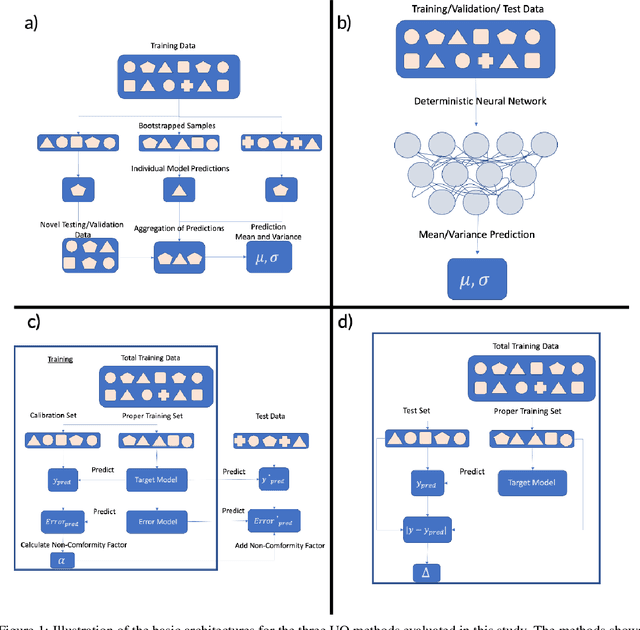

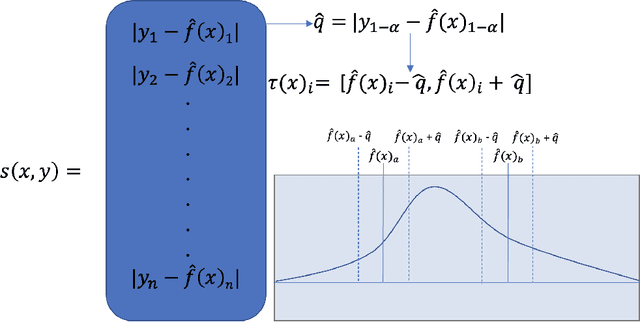
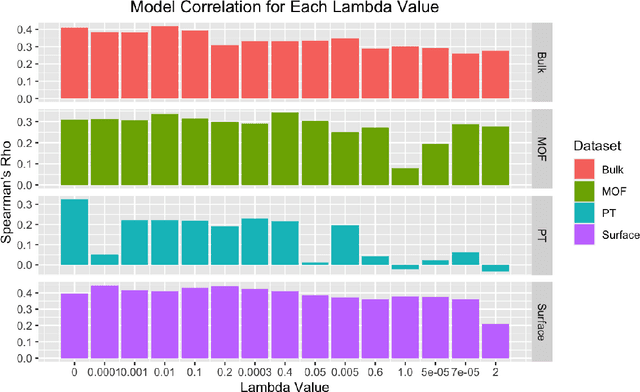
Abstract:Uncertainty quantification (UQ) has increasing importance in building robust high-performance and generalizable materials property prediction models. It can also be used in active learning to train better models by focusing on getting new training data from uncertain regions. There are several categories of UQ methods each considering different types of uncertainty sources. Here we conduct a comprehensive evaluation on the UQ methods for graph neural network based materials property prediction and evaluate how they truly reflect the uncertainty that we want in error bound estimation or active learning. Our experimental results over four crystal materials datasets (including formation energy, adsorption energy, total energy, and band gap properties) show that the popular ensemble methods for uncertainty estimation is NOT the best choice for UQ in materials property prediction. For the convenience of the community, all the source code and data sets can be accessed freely at \url{https://github.com/usccolumbia/materialsUQ}.
Materials Transformers Language Models for Generative Materials Design: a benchmark study
Jun 27, 2022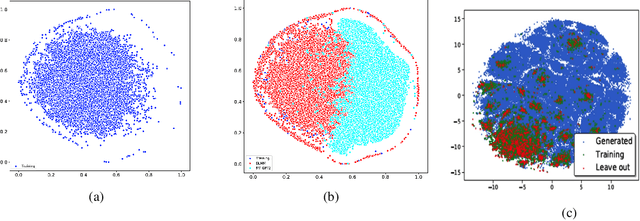

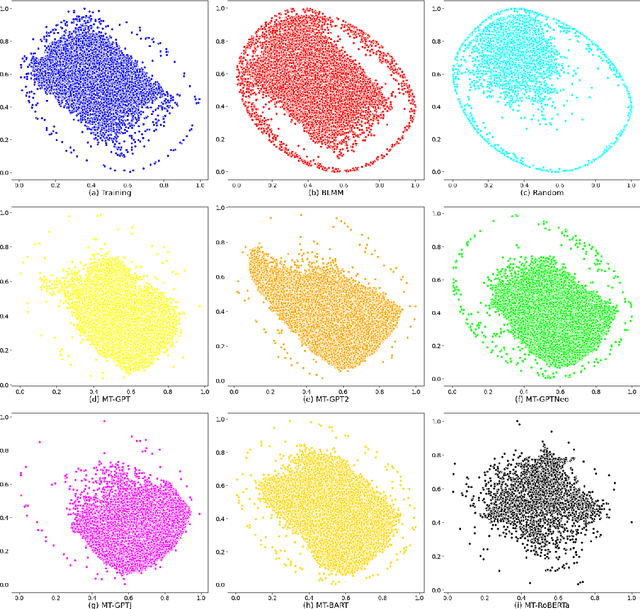
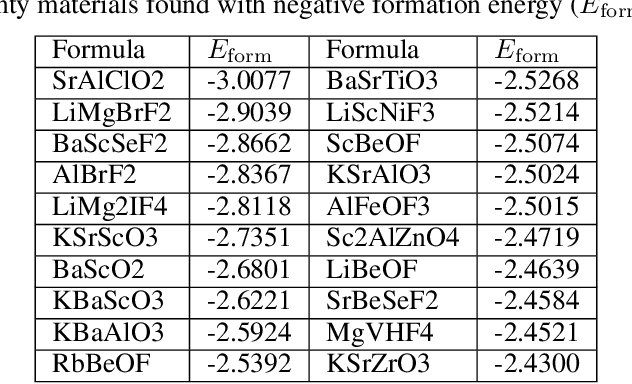
Abstract:Pre-trained transformer language models on large unlabeled corpus have produced state-of-the-art results in natural language processing, organic molecule design, and protein sequence generation. However, no such models have been applied to learn the composition patterns of inorganic materials. Here we train a series of seven modern transformer language models (GPT, GPT-2, GPT-Neo, GPT-J, BLMM, BART, and RoBERTa) using the expanded formulas from material deposited in the ICSD, OQMD, and Materials Projects databases. Six different datasets with/out non-charge-neutral or balanced electronegativity samples are used to benchmark the performances and uncover the generation biases of modern transformer models for the generative design of materials compositions. Our extensive experiments showed that the causal language models based materials transformers can generate chemically valid materials compositions with as high as 97.54\% to be charge neutral and 91.40\% to be electronegativity balanced, which has more than 6 times higher enrichment compared to a baseline pseudo-random sampling algorithm. These models also demonstrate high novelty and their potential in new materials discovery has been proved by their capability to recover the leave-out materials. We also find that the properties of the generated samples can be tailored by training the models with selected training sets such as high-bandgap materials. Our experiments also showed that different models each have their own preference in terms of the properties of the generated samples and their running time complexity varies a lot. We have applied our materials transformer models to discover a set of new materials as validated using DFT calculations.
Scalable deeper graph neural networks for high-performance materials property prediction
Sep 25, 2021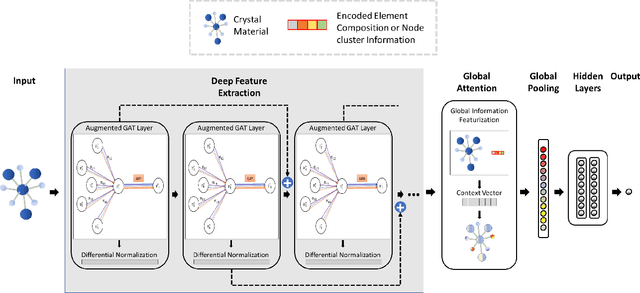

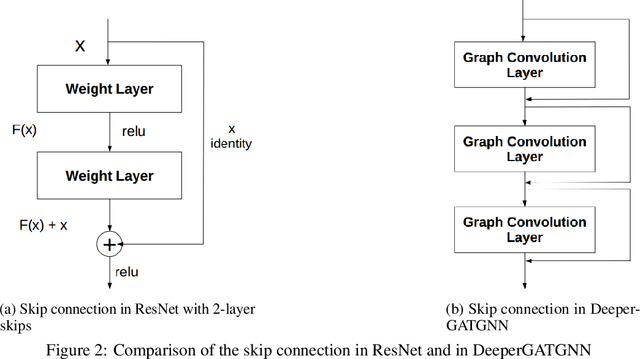
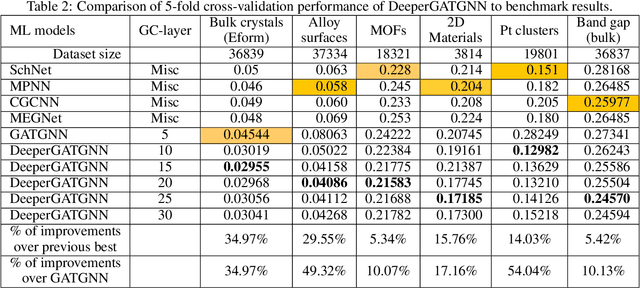
Abstract:Machine learning (ML) based materials discovery has emerged as one of the most promising approaches for breakthroughs in materials science. While heuristic knowledge based descriptors have been combined with ML algorithms to achieve good performance, the complexity of the physicochemical mechanisms makes it urgently needed to exploit representation learning from either compositions or structures for building highly effective materials machine learning models. Among these methods, the graph neural networks have shown the best performance by its capability to learn high-level features from crystal structures. However, all these models suffer from their inability to scale up the models due to the over-smoothing issue of their message-passing GNN architecture. Here we propose a novel graph attention neural network model DeeperGATGNN with differentiable group normalization and skip-connections, which allows to train very deep graph neural network models (e.g. 30 layers compared to 3-9 layers in previous works). Through systematic benchmark studies over six benchmark datasets for energy and band gap predictions, we show that our scalable DeeperGATGNN model needs little costly hyper-parameter tuning for different datasets and achieves the state-of-the-art prediction performances over five properties out of six with up to 10\% improvement. Our work shows that to deal with the high complexity of mapping the crystal materials structures to their properties, large-scale very deep graph neural networks are needed to achieve robust performances.
Crystal structure prediction of materials with high symmetry using differential evolution
Apr 20, 2021



Abstract:Crystal structure determines properties of materials. With the crystal structure of a chemical substance, many physical and chemical properties can be predicted by first-principles calculations or machine learning models. Since it is relatively easy to generate a hypothetical chemically valid formula, crystal structure prediction becomes an important method for discovering new materials. In our previous work, we proposed a contact map-based crystal structure prediction method, which uses global optimization algorithms such as genetic algorithms to maximize the match between the contact map of the predicted structure and the contact map of the real crystal structure to search for the coordinates at the Wyckoff Positions(WP). However, when predicting the crystal structure with high symmetry, we found that the global optimization algorithm has difficulty to find an effective combination of WPs that satisfies the chemical formula, which is mainly caused by the inconsistency between the dimensionality of the contact map of the predicted crystal structure and the dimensionality of the contact map of the target crystal structure. This makes it challenging to predict the crystal structures of high-symmetry crystals. In order to solve this problem, here we propose to use PyXtal to generate and filter random crystal structures with given symmetry constraints based on the information such as chemical formulas and space groups. With contact map as the optimization goal, we use differential evolution algorithms to search for non-special coordinates at the Wyckoff positions to realize the structure prediction of high-symmetry crystal materials. Our experimental results show that our proposed algorithm CMCrystalHS can effectively solve the problem of inconsistent contact map dimensions and predict the crystal structures with high symmetry.
 Add to Chrome
Add to Chrome Add to Firefox
Add to Firefox Add to Edge
Add to Edge